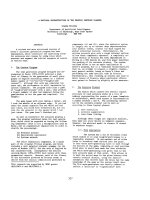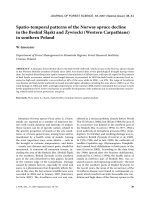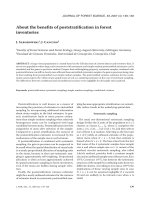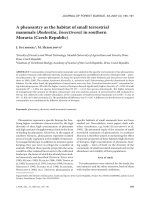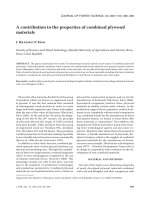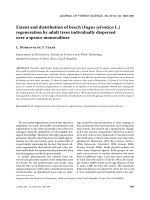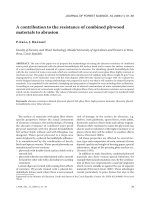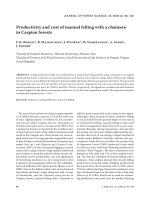Báo cáo lâm nghiệp: " A dendroecological reconstruction of disturbance in an old-growth Fagus-Abies forest in Slovenia" docx
Bạn đang xem bản rút gọn của tài liệu. Xem và tải ngay bản đầy đủ của tài liệu tại đây (2.32 MB, 7 trang )
Ann. For. Sci. 64 (2007) 891–897 Available online at:
c
INRA, EDP Sciences, 2007 www.afs-journal.org
DOI: 10.1051/forest:2007067
Original article
A dendroecological reconstruction of disturbance in an old-growth
Fagus-Abies forest in Slovenia
Thomas A. Nagel
a
*
,TomL
evanic
b
,JurijDiaci
a
a
University of Ljubljana, Biotechnical Faculty, Department of Forestry and Renewable Forest Resources, Ve
ˇ
cna Pot 83, 1000 Ljubljana, Slovenia
b
Slovenian Forestry Institute, Ve
ˇ
cna Pot 2, 1000 Ljubljana, Slovenia
(Received 24 November 2006; accepted 28 March 2007)
Abstract – The scarcity of large old-growth forests has made it challenging to quantify disturbance regimes in Central Europe. The objective of
this study was to reconstruct the history of disturbance in an old-growth Fagus-Abies forest reserve in Slovenia using a dendroecological approach. We
extracted cores from canopy trees blown down during a recent windthrow event and identified growth releases in the tree-ring series using boundary-line
release criteria to infer past disturbances. A total of 216 release events were identified from 88 trees. Between 1790 and 1990, moderate, asynchronous
release events were present in nearly every decade of the disturbance chronology, suggesting a history of frequent, low severity disturbance. However,
there were also peaks in the chronology corresponding to synchronous release events in a large proportion of the trees, suggesting that less frequent,
intermediate severity disturbance events played an important role in forest development. These events are likely caused from wind damage associated
with local thunderstorms, which seem to occur at intervals between 20–80 years on the study site. Thus, in addition to the small-scale gap phase processes
operating in the forest, the results indicate that periodic intermediate severity disturbance events are an important component of the disturbance regime
in mountain forests of Central Europe.
dendroecology / forest dynamics / Fagus sylvatica / Abies alba / forest development
Résumé – Reconstruction dendroécologique des perturbations dans une hêtraie sapinière ancienne en Slovénie. Le faible nombre de forêts
anciennes suffisamment étendues rend difficile la quantification des régimes de perturbation en Europe centrale. L’objectif de cette étude est de re-
constituer l’histoire de ces perturbations dans une hêtraie-sapinière ancienne mise en réserve en Slovénie en utilisant une approche dendroécologique.
Des carottes ont été extraites du tronc d’arbres dominants renversés lors d’un récent chablis. Les séries temporelles de cernes ont été analysées pour
identifier des périodes de relâchement de contraintes de croissance et pour en déduire l’intensité des perturbations passées. Un total de 216 évènements
de relâchement de contrainte a été identifié pour 88 arbres. Entre 1790 et 1990, des évènements d’intensité modérée et asynchrones ont été détectés
dans les séries chronologiques au cours de pratiquement toutes les décennies. Cela suggère une fréquence élevée de perturbations de faible intensité.
Cependant, des pics d’enregistrement d’évènements synchrones ont été identifiés dans la chronologie dans une proportion importante d’arbres. Cela
suggère que des perturbations de sévérité intermédiaire ont joué un rôle important dans le développement de la forêt, malgré leur plus faible fréquence.
Ces évènements ont probablement été causés par des chablis provoqués par des orages locaux violents, qui semblent se produire à des intervalles de
20 à 80 ans sur le site d’étude. Les résultats montrent ainsi qu’en sus de perturbations locales de faible intensité conduisant à la formation de petites
trouées, les perturbations périodiques de sévérité intermédiaire constituent une composante importante du régime de perturbations dans les montagnes
en Europe centrale.
dendroécologie / dynamique forestière / Fagus sylvatica / Abies alba / développement forestier
1. INTRODUCTION
In temperate, old-growth forests of Central Europe, nat-
ural disturbance events, such as windstorms or insect out-
breaks, have traditionally been underemphasized in conceptual
models of forest dynamics. Instead, disturbance was mostly
viewed as a continuous, endogenous tree mortality process,
where small-sale gap-phase dynamics drive canopy recruit-
ment [16,19,31]. This model of forest dynamics was based on
early descriptive studies in old-growth remnants, which often
used maps of developmental phases based on forest structure
to infer stand dynamics [15, 18, 24, 25]. These studies, how-
ever, were supported by little to no tree age data and did not
take advantage of the dendroecological techniques available
today, making it difficult to understand the complexity of the
processes leading to a particular forest structure and composi-
* Corresponding author:
tion. It is well established that annual radial growth patterns in
tree cores, along with tree age and recruitment data, can pro-
vide valuable insights into the frequency and severity of nat-
ural disturbance events [22]. Indeed, this type of information
is lacking for old-growth stands in Central Europe, making it
challenging to quantify disturbance regime components.
More recently, forest ecologists have begun to place more
emphasis on studies of disturbance in Central European old-
growth forests. There have been a number of recent studies on
canopy gaps, which have helped identify the disturbance pro-
cesses that lead to gap formation [8, 28,38, 49]. Large canopy
gaps (> 1000 m
2
) with multiple windthrown gap-makers re-
ported in these studies suggest that less frequent, but more
intense disturbance events, such as windstorms, may play an
important role in creating larger canopy openings. For ex-
ample, in the Pecka old-growth, beech-fir forest in Slove-
nia, two strong thunderstorm events in 1983 and 2004 caused
Article published by EDP Sciences and available at or />892 T.A. Nagel et al.
intermediate damage to the canopy, creating a maze of in-
terconnected canopy gaps up to 1500 m
2
in size [27]. The
canopy openings formed during the 1983 storm promoted a
coarse-grained network of regeneration, which may have long-
term consequences on forest structure [28]. In support of this,
recent dendroecological studies in similar old-growth, beech-
fir-spruce and beech dominated stands in Austria and Italy, re-
spectively, found evidence of higher intensity, periodic distur-
bance events that thinned portions of the canopy in the past
[30,39].
These studies suggest that disturbance regimes in old-
growth temperate forests of Central Europe may not be as sim-
ple as those described in the early literature, and that less fre-
quent, intermediate intensity disturbance events likely played
an important role in their development. Certainly, one of the
most accurate ways of reconstructing disturbance histories in
temperate forests is to use dendroecological techniques based
on the identification of abrupt growth releases in tree cores [1,
9, 23, 32, 44]. Under this approach, synchronous release from
many trees in the same stand suggests larger, more intense
canopy disturbance occurred in the past, while many asyn-
chronous release events are indicative of small-scale, single-
tree canopy disturbances [22]. The purpose of this study was to
reconstruct the disturbance history of the Pecka forest reserve
in Slovenia by identifying abrupt growth releases in tree cores.
Understandably, tree coring is often prohibited in Central Eu-
ropean old-growth reserves due to their scarcity and small size,
as is the case in Slovenia. To overcome this problem, we cored
trees that were freshly blown-down during the 2004 summer
storm in the reserve. Our specific objectives were (1) to de-
termine if disturbance is episodic or constant over time; and
(2) to examine if there is evidence of less frequent, high inten-
sity disturbance events in the past.
2. MATERIALS AND METHODS
2.1. Study area
This study was conducted in the Pecka forest reserve, a 60 ha old-
growth European beech (Fagus sylvatica L.) and silver fir (Abies alba
Mill.) forest remnant located on a high karst plateau (900 m) in the
Dinaric Alps, southeastern Slovenia (45
◦
754’ N, 14
◦
995’ E). The
karst geology on the site is characterized by abundant sinkholes and
limestone outcrops, resulting in a diverse micro-topography. Calcare-
ous brown soils on the site are derived from the limestone parent
material, and soil depth can vary between 30 and 70 cm depend-
ing on micro-topographic position. The climate is a combination of
continental and Mediterranean, with an annual precipitation of ca.
1400 mm and mean monthly temperatures between –4
◦
C in January
and 20.3
◦
CinJuly.
The forest is dominated by F. sylvatica (81%) and A. alba (19%),
but also includes less abundant species, such as Norway spruce
(Picea abies Karst.), maple (Acer pseudoplatanus L.), and elm (Ul-
mus glabra Huds.). Fagus sylvatica regeneration is well developed
throughout much of the understory, which is primarily the result of
increased understory light levels caused by the gradual decline of A.
alba in the reserve over the second half of the 20th century [34, 42].
Regeneration of A. alba has also been substantially reduced by brows-
ing pressure from a large red and roe deer population [6, 7]. Finally,
a few scattered A. alba in parts of the reserve were selectively cut
during the1940s.
2.2. Data collection and analysis
Immediately following the windthrow in July, 2004, all canopy
layer trees blown down during the storm (n = 70) were cored at ap-
prox. 1 m. We supplemented these samples with other freshly downed
or standing dead trees, which died earlier that year or one year prior
(n = 18). Trees that died earlier than this were usually too decayed for
extraction of intact cores. The cores were mounted and sanded to a
high polish following standard dendrochronological procedures [40],
and were visually cross-dated by identifying narrow marker years
in each tree core [48]. Due to extended periods of very suppressed
growth with possible missing rings in the beech cores [33, 39], we
were unable to successfully cross-date many of these samples. How-
ever, because we summarize disturbance by decade, dating errors of
one or two years should have little effect on the accuracy of the re-
sults. The cores were then digitized and annual radial growth was
measured to the nearest 0.01 mm using WinDENDRO
TM
software.
Release events were identified in each core using boundary-line
release criteria [2], which provides a standardized approach to re-
lease detection. Black and Abrams [2] demonstrate that slow grow-
ing trees release more vigorously than fast growing trees, and that the
maximum possible value of a pulse in percent-growth-change is de-
pendent on the growth rate immediately prior to the pulse. Moreover,
this relationship between release potential and prior growth is species
specific and, at least for some species, is consistent across much of its
range, so that a universal boundary-line function can be constructed
for a species. The boundary-line is then used to scale release events
by the maximum possible value predicted by prior growth rate, which
allows for direct comparisons of disturbance histories among differ-
ent stands.
The boundary-line method follows a few simple steps. First,
percent-growth change values for each ring in each tree-ring series
are calculated according to the running mean technique of Nowacki
and Abrams [29]. Under this approach, percent growth change for
a year is equal to (M
2
–M
1
)/M
1
× 100, where M
1
is equal to aver-
age radial growth over the preceding ten year period (inclusive of the
disturbance year), and M
2
equals average radial growth over the sub-
sequent 10 years (exclusive of the disturbance year). This is followed
by calculating prior growth for each year in the tree-ring series, which
is simply the average radial growth over the 10 years before the dis-
turbance year. The relationship between percent-growth change and
prior growth is then plotted for each year of every tree-ring series,
excluding the first and last ten years in each series due to limitations
of the formulas. Finally, a boundary line function fitted to the upper
threshold of this relationship is quantified.
For this study, we used boundary-line functions recently devel-
oped for both F. sylvatica and A. alba [39]. The relationship be-
tween percent-growth change and prior growth for F. sylvatica on
our study site fit the F. sylvatica boundary line well, with percent-
growth change pulses that approached the boundary-line. However,
our A. alba data failed to reach the previously developed boundary-
line at levels of prior growth > 0.3 mm. Black and Abrams [2] also
found that some Tsuga canadensis sites did not approach the bound-
ary line developed for this species, and suggested that differences in
genotype, site conditions, range position, and disturbance history may
account for variation in release response. The previously developed
boundary line for A. alba was mainly constructed from chronologies
north of our study region, which may explain why our site differed
in release response. Consequently, we decided to create a regional
boundary-line for A. alba using data from this study and chronol-
ogy data from five other sites located in the Dinaric mountains of
Disturbance history of an old-growth forest 893
-400
0
400
800
1200
1600
2000
2400
2800
012345678
9
Percent growth change
Prior growth (mm)
GC = 266.138 + 2827.365 e
(-3.259 PG)
- 44.963 PG
R
2
= 0.980
Figure 1. Plot of percent-growth change values (GC)
with respect to prior growth (PG) for 33 549 A. alba
annual growth increments from five sites in Slovenia,
showing the regional boundary line.
Slovenia [20, 21]. The data set was divided into 0.5 mm segments of
prior growth and the ten highest growth change values in each seg-
ment were averaged. However, because there was a steep decline in
growth change at low levels of prior growth, we followed the sugges-
tion of Splechtna et al. [39] and divided prior growth up to 1.0 mm
into 0.25 mm segments. For these segments, only the top five values
were averaged. Finally, we fit a modified negative exponential func-
tion with an additional linear term to the segment averages. The final
boundary line was based on 33 549 tree rings (Fig. 1).
The next step of this approach was to scale all the potential release
events relative to the boundary line for each species. To do this, we
selected the maximum percent-growth change value for each growth
pulse identified with the Nowacki and Abrams [29] running mean for-
mula, which should be an accurate estimation of the disturbance year
[29, 32]. The remaining percent-growth change values were dropped
from the analysis. Next, percent-growth change values above a par-
ticular threshold level were scaled as a fraction of the boundary line
by dividing the observed percent-growth change value by the value of
the boundary line at a given level of prior growth. Black and Abrams
[2] suggest including all percent-growth change values above 10%,
while Splechtna et al. [39] only included values above 50% in their
study of disturbance history in an Austrian fir-beech-spruce forest.
For this study, we included all percent-growth change values above
25%. After scaling each value with respect to the boundary-line for
each analysis, moderate releases were classified as those pulses >
20% of the boundary-line, and major releases as pulses > 50% of
the boundary-line [2]. Pulses falling below 20% of the boundary-line
were excluded to screen out growth increases caused by climate. Fi-
nally, disturbance chronologies were constructed based on the num-
ber of cores showing a release each decade.
3. RESULTS
From the 88 canopy trees included in the analysis, a total
of 386 maximum percent-growth-change values > 25% were
identified with the Nowacki and Abrams [29] running mean
formula. After scaling these events relative to the boundary
line for each species, 216 qualified as release events, 32 of
-400
0
400
800
1200
1600
2000
2400
012345
Percent growth change
Prior growth (mm)
-400
0
400
800
1200
1600
2000
0123
B) Abies alba
not a release
moderate release
major release
A) Fagus sylvatica
Figure 2. Plot of all maximum percent-growth change values from ra-
dial growth pulses > 25% calculated from the Nowacki and Abrams
(1997) formula for F. sylvatica (A) and A. alba (B). Maximum
percent-growth change values scaled with respect to the boundary
line for each species were classified by major releases (above 50% of
the value of the boundary line) and moderate releases (between 20%
and 50% of the value of the boundary line). Values less than 20% of
the boundary line were not considered releases.
894 T.A. Nagel et al.
1780
1790
1800
1810
1820
1830
1840
1850
1860
1870
1880
1890
1900
1910
1920
1930
1940
1950
1960
1970
1980
1990
0
5
10
15
20
25
30
0
20
40
60
80
100
Percentage of trees showing release
Sampling depth (No. of trees)
Decade
Number of trees showing release
5
10
15
20
25
20
40
60
80
100
moderate
major
tree number
Figure 3. Disturbance chronology from the Pecka old-growth forest reserve showing a decadal distribution of both the total and relative number
of major and moderate releases identified with the boundary-line release critera. The sample depth for each decade is indicated by lines.
which were major release events (above 50% of the value of
the boundary line) and 184 of which were moderate releases
(between 20% and 50% of the value of the boundary line)
(Fig. 2). The average number of release events per tree was
2.79 and 2.25 for beech and fir, respectively. The disturbance
chronology constructed from the boundary line release events
showed that releases occurred in nearly all decades over the
last 200 years (Fig. 3). Furthermore, the number of trees show-
ing release each decade varied considerably over the past two
centuries, with large peaks in disturbance in the 1980s, 1950s,
and 1880s. In the oldest portion of the chronology the number
of trees showing release was low, but this was mainly an arti-
fact of the drop in sampling depth after the 1880s. However,
the percentage of trees that released each decade was high in
many decades during the oldest part of the chronology, espe-
cially between the 1790s and 1840s. Moreover, many of the
disturbance events in the early part of the chronology were
major release events. There were also periods with especially
low levels of disturbance. For example, between the 1890s and
1940s, less than 15% of trees showed release in each decade.
4. DISCUSSION
Moderate release events where present in nearly every
decade of the disturbance chronology. In regard to our first
research objective, however, disturbances were not constant
over time, but varied over the past several hundred years. The
relative number of disturbance events was much higher in the
19th century compared to the first half of the 20th century. Fur-
thermore, the older part of the chronology was characterized
by more major release events compared to the 20th century.
However, it is difficult to determine if the higher percentage of
releases in the early portion of the chronology is an artifact of
the sampling depth or reflects an increased disturbance rate.
In regard to our second research objective, there were large
peaks in the disturbance chronology in several decades, sug-
gesting that moderate to high severity disturbance events oc-
curred episodically in the past several hundred years. For ex-
ample, before the drop in the chronology sampling depth, large
disturbance pulses were found in the 1880s, 1950s, and 1980s.
The peak in the 1980s corresponds with a severe storm event
that caused widespread damage in the reserve in 1983, blow-
ing down more than 300 canopy layer trees [27], indicating
that the boundary line approach is an appropriate method for
detecting past disturbance events in our study site. The large
peaks in the 1950s and 1880s likely correspond to widespread
damage caused by similar severe, local storms in the reserve.
We made a thorough examination of all the available historical
forest inventory records from the study area spanning the pe-
riod 1892–1972 [12,13,37], but there were no written accounts
of these events. This is likely because prior to the 1980s, forest
inventory records from the study area were infrequent and of
insufficient detail to record localized damage from infrequent
storm events. The only storm event mentioned in the forest
records occurred during the 1920s, which damaged trees in a
broader area near the study site, but the specific location could
not be determined.
Disturbance history of an old-growth forest 895
Contemporary evidence of the 1950s event, such as decayed
logs on the forest floor, was difficult to find in the reserve. This
is mainly because Fagus sylvatica logs decompose after about
30–40 years in this region [17], although A. alba logs likely
take longer to disappear. We did find old tip and mounds in
the area we sampled, as well as highly decayed fir logs. There
were also scattered, old gaps present, which were being closed
by understory beech trees around 10–20 cm dbh. However, it is
difficult to ascertain the origin of this evidence without further
dendroecological studies on live trees, which are not permitted
in the reserve. It is also possible that the releases found in the
1950s could correspond to snow or ice damage from a winter
storm. These events often cause widespread damage to tree
crowns rather than uprooting or snapping entire trees, which
could partly explain the lack of structural evidence of a major
storm in the 1950s.
It appears from the results of this study that both frequent,
low severity disturbances causing small-scale canopy gaps as
well as periodic, higher severity events play a role in forest dy-
namics in our study area. This is in agreement with the widely
accepted gap-phase paradigm in Central Europe, but is also in
support of dendroecological studies indicating the occurrence
of less frequent, moderate to high intensity disturbance events
[39,41]. Furthermore, recent canopy gap studies in old-growth
F. sylvatica dominated forests in Bosnia-Herzegovina (Nagel
and Svoboda, unpublished data), Slovenia [49], Austria [38],
and Slovakia [8] documented large canopy openings with mul-
tiple windthrown gapmakers. For example, in two old-growth
stands studied by Drössler and von Lüpke [8], several gaps
greater than 0.4 ha with more than 50 gapmakers, many of
which were windthrown, show the importance of strong wind-
storm events in this region.
This type of wind damage is likely caused by high veloc-
ity, localized windbursts associated with strong thunderstorm
events. While other disturbance agents, such as insects attacks
and heavy snow or ice damage also occur in the mountains of
Central Europe, wind accounts for most of the damage in this
region [35]. Rather than causing complete, localized canopy
destruction, these storm events cause intermediate level dam-
age, characterized by a fine-grained mosaic of canopy damage
in a matrix of undisturbed forest, including the creation of in-
termediate sized canopy openings (> 1000 m
2
) [4, 27, 38,47].
Based on the spatial and temporal scale of this study, it is diffi-
cult to determine if these intermediate events occur in a stable
manner. In general, it appears that storms of higher than nor-
mal intensity occurred at intervals between 20–80 years over
the past 200 years for the study area. The occurrence of fre-
quent thunderstorm events in the study region is also supported
by meteorological data [11,28].
These events have important implications on forest devel-
opment, depending on the stand structure and composition at
the time of disturbance, as well as the timing of subsequent
disturbances. In an old-growth fir-beech-spruce stand in Aus-
tria studied by Splechtna et al. [39], fine-scale neighborhood
processes, including gap closure by lateral crown expansion
and gradual gap expansion over time, influenced the trajec-
tory of forest development following disturbance. Certainly,
the formation of many small to intermediate sized gaps in a
0
50
100
150
200
250
300
350
0 102030405060708090
Diameter at breast height (cm)
Figure 4. Plot of diameter versus age (at a coring height of 1 m) for
F. sylvatica trees > 20 cm dbh. Only cores that reached or were very
close to the pith were included. For cores that were close to the pith,
the number of missing rings to the pith was estimated based on the
average growth rate of the last five visible rings.
forest stand during a storm may lead to increased survival of
understory saplings and trees. Subsequent canopy recruitment
of these individuals is largely dependent on whether the gaps
formed in the storm close or expand. In the Pecka forest re-
serve, for example, the widespread canopy damage created
during the 1983 storm caused major recruitment of advanced
regeneration throughout the area of the stand damaged by the
storm [28]. The recent storm in 2004 expanded many of the
gaps created in the 1983 event, probably because trees border-
ing larger openings were exposed to winds during the storm
[27]. The expansion of these larger gaps will likely lead to
formation of broad cohorts of regeneration at intermediate to
coarse-scales.
An examination of stand structure alone, such as map-
ping development phases or measuring diameter distributions,
may not provide sufficient information on the complex his-
tory of low to intermediate severity disturbances that shape
stand development in this region. Defining different develop-
ment phases in forest stands is difficult, and mapping their
boundaries is very subjective, especially in stands with fine-
scale structural heterogeneity, such as the temperate forests in
Central Europe. At best, successive mapping of development
phases over time can provide useful insight into coarse-scale
structural changes [5, 26], but at worst they may lead to spu-
rious inferences about the processes that led to a particular
forest structure [14]. Similarly, diameter structure data, which
have been used to make inferences about forest development in
Central European forests [45,46], can also be problematic be-
cause of a poor relationship between size and age [22,30, 43].
When we examined this relationship for the Fagus trees > 20
cm dbh used in this study, a regression analysis showed a week
relationship (R
2
= 0.20, p = 0.003) (Fig. 4). Unless a strong
relationship between size and age is demonstrated, diameter
structure data are of little use in interpreting stand develop-
ment. We believe that dendroecological data in addition to the
896 T.A. Nagel et al.
more traditional approaches that focus on stand structure are
needed for a more comprehensive understanding of forest de-
velopment.
5. CONCLUSIONS
Describing disturbance regimes is challenging in Central
Europe because of the scarcity of old-growth reference con-
ditions where these processes can be studied. Nevertheless,
much attention has been given to applying natural disturbance
based processes to silvicultural practices [10, 36], especially
in regard to unevenaged, “close-to-nature” selection systems
in Central Europe [3]. This study provides further support that
the disturbance regime in this region is not only characterized
by small-scale, endogenous tree mortality processes, but also
by intermediate severity windstorm events that likely occur at
time scales less than average tree longevity. Silvicultural pre-
scriptions could mimic these events with periodic, higher in-
tensity selective cuts, including the creation of multiple tree
gaps. However, if forest managers are to mimic natural dis-
turbance processes in harvesting schemes, a more thorough
understanding of the various components of the disturbance
regime (i.e. type, frequency, severity, size, etc.) is still needed.
We therefore suggest a more multifaceted approach to study-
ing old growth forest development and dynamics in Central
Europe. Less emphasis should be placed on describing and
mapping developmental phases and more attention should be
given to the processes and mechanisms that are responsible
for forest development. Dendroecological studies are just one
of the approaches that can provide valuable insight into the
processes that led to a particular forest structure and compo-
sition. In strict forest reserves where tree coring is prohibited,
the results of this study show that freshly dead trees can yield
valuable material for dendroecological reconstructions of dis-
turbance history.
Acknowledgements: We thank M. Svoboda for assistance in the
field. We are also very grateful to B. Black for providing helpful
advice and assistance with the boundary line release analysis. Field
work was partly supported by a Fulbright grant.
REFERENCES
[1] Abrams M.D., Orwig D.A., A 300-year history of disturbance and
canopy recruitment for co-occurring white pine and hemlock on the
Allegheny Plateau, USA, J. Ecol. 84 (1996) 353–363.
[2] Black B.A., Abrams M.D., Use of boundary-line growth patterns as
a basis for dendroecological release criteria, Ecol. Appl. 13 (2003)
1733–1749.
[3] Brang P., Virgin forests as a knowledge source for central European
silviculture: reality or myth? For. Snow Landsc. Res. 79 (2005) 19–
32.
[4] Canham C.D., Papaik M.J., Latty E.F., Interspecific variation in sus-
ceptibility to windthrow as a function of tree size and storm sever-
ity for northern temperate tree species, Can. J. For. Res Rev. Can.
Rech. For. 31 (2001) 1–10.
[5] Christensen M., Emborg J., Neilsen A.B., The forest cycle of
Suserup Skov-revisited and revised, Ecol. Bull. 52 (2007) 33–42.
[6] Debeljak M., Jelka (Abies alba Mill.) v pomladku pragozda Pecka
v zadnjih tridesetih letih (Silver fir in the new growth of the Pecka
virgin forest in the last thirty years), Zb. Gozd. Lesar. 53 (1997)
29–48.
[7] Diaci J., Boncina A., Aktuelle Forschungsergebnisse zur natür-
lichen Verjüngung in bergwäldern Sloweniens, FBVA Ber. 130
(2003) 57–65.
[8] Drösser L., von Lüpke B., Canopy gaps in two virgin beech forest
reserves in Slovakia, J. For. Sci. 51 (2005) 446–457.
[9] Frelich L.E., Lorimer C.G., Natural disturbance regimes in hemlock
hardwood forests of the upper great-lakes region, Ecol. Monogr. 61
(1991) 145–164.
[10] Harvey B., Abstracts of the conference on Natural disturbance-
based silviculture: Managing for complexity, Rouyn-Noranda, QC,
Canada, 2006.
[11] Hocevar A., Petkovsek Z., Meteorologija, Ljubljana, 1984.
[12] Hufnagl L., Wirtschaftsplan der Betriebsklasse 1, Göttenitzer
Gebirge, Kocevje, 1892.
[13] Komel L., Gospodarski nacrt za gozdno-gospodarsko enoto Soteska
(1963–1972), Ljubljana, 1968.
[14] Konecnik K., Zaplotnik V., Virgin forest reserve Strmec-Research
on natural forest structures and comparison of selected methods,
Department of Forestry, University of Ljubljana, Ljubljana, 2001,
p. 107.
[15] Korpel S., Degree of equilibrium and dynamical changes of the
forest on example of natural forests of Slowakia, Acta Facutatis
Forestalis, Zvolen, Czechoslovakia 24 (1982) 9–30.
[16] Korpel S., Die Urwälder der Westkarpaten, Gustav Fischer Verlag,
Stuttgart, Jena, New York, 1995.
[17] Kraigher H., Jurc D., Kalan P., Kutnar L., Levanic T., Rupel M.,
Smolej I., Beech coarse woody debris characteristics in two virgin
forest reserves in southern Slovenia, Zb. Gozd. Lesar. 69 (2002) 91–
134.
[18] Leibundgut H., Über Zweck und Methodik der Struktur und
Zuwachsanalyse von Urwäldern, Schweiz. Z. Forstwes. 110 (1959)
111–124.
[19] Leibundgut H., Europäische Urwälder der Bergstufe, Haupt, Bern,
1987.
[20] Levanic T., Growth depression of silver fir (Abies alba Mill.) in
the Dinaric phytogeographic region between 1960–1995, Zb. Gozd.
Lesar. 52 (1997) 137–164.
[21] Levanic T., Èufar K., Comparison of standard chronologies of silver
fir (Abies alba Mill.) in Dinaric phytogeografical region in Slovenia,
Zb. Gozd. Lesar. 46 (1995) 131–144.
[22] Lorimer C.G., Methodological considerations in the analysis of for-
est disturbance history, Can. J. For. Res Rev. Can. Rech. For. 15
(1985) 200–213.
[23] Lorimer C.G., Frelich L.E., A methodology for estimating canopy
disturbance frequency and intensity in dense temperate forests, Can.
J. For. Res Rev. Can. Rech. For. 19 (1989) 651–663.
[24] Mayer H., Neumann M., Struktureller und entwicklungsdynamis-
cher Vergleich der Fichten-Tannen-Buchen-Urwälder Rothwald-
Niederösterreich und Corkova Uvala-Kroatien, Forstw. Cbl 100
(1981) 111–132.
[25] Mayer H., Zukrigl K., Schrempf W., Schlager G., Urwaldreste,
Naturwaldreservate und schützenswerte Naturwälder in Österreich,
Institut für Waldbau, Universität für Bodenkultur, Wien, 1989.
[26] Mocilnikar H., Regeneration dynamics of the old-growth forest
remnant Rajhenavski Rog, Department of Forestry, University of
Ljubljana, Ljubljana, 2006, p. 75.
[27] Nagel T.A., Diaci J., Intermediate wind disturbance in an old-
growth beech-fir forest in southeastern Slovenia, Can. J. For. Res
Rev. Can. Rech. For. 36 (2006) 629–638.
Disturbance history of an old-growth forest 897
[28] Nagel T.A., Svoboda M., Diaci J., Regeneration patterns after in-
termediate wind disturbance in an old-growth Fagus-Abies forest in
southeastern Slovenia, For. Ecol. Manage. 226 (2006) 268–278.
[29] Nowacki G.J., Abrams M.D., Radial-growth averaging criteria for
reconstructing disturbance histories from presettlement-origin oaks,
Ecol. Monogr. 67 (1997) 225–249.
[30] Piovesan G., Di Filippo A., Alessandrini A., Biondi F., Schirone
B., Structure, dynamics and dendroecology of an old-growth Fagus
forest in the Apennines, J. Veg. Sci. 16 (2005) 13–28.
[31] Prusa E., Die böhmischen und mährischen Urwälder – ihre Struktur
und Ökologie, Verlag der Tschechoslowakischen Akademie der
Wissenschaften, Praga, 1985.
[32] Rentch J.S., Fajvan M.A., Hicks R.R., Spatial and temporal dis-
turbance characteristics of oak-dominated old-growth stands in the
central hardwood forest region, For. Sci. 49 (2003) 778–789.
[33] Rozas V., Tree age estimates in Fagus sylvatica and Quercus robur:
testing previous and improved methods, Plant Ecol. 167 (2003)
193–212.
[34] Rozenbergar D., Razvojne znacilnosti sestojev v pragozdnih os-
tankih Pecka in Rajhenavski Rog (Stand dynamics of the virgin
forest remnants of Pecka and Rajhenavski Rog), Gozd. Vestn. 58
(2000) 53–55 (in Slovenian).
[35] Schelhaas M.J., Nabuurs G.J., Schuck A., Natural disturbances in
the European forests in the 19th and 20th centuries, Glob. Change
Biol. 9 (2003) 1620–1633.
[36] Schutz J.P., Uneven-aged silviculture: tradition and practices,
Forestry 75 (2002) 327–328.
[37] Sivic A., Gospodarska osnova za gozdove grascin Soteska,
Zuzemberk in Visnja gora, Novo mesto, 1930.
[38] Splechtna B.E., Gratzer G., Natural disturbances in Central
European forests: approaches and preliminary results from
Rothwald, Austria, For. Snow Landsc. Res. 79 (2005) 57–67.
[39] Splechtna B.E., Gratzer G., Black B.A., Disturbance history of
a European old-growth mixed-species forest – A spatial dendro-
ecological analysis, J. Veg. Sci. 16 (2005) 511–522.
[40] Stokes M.A., Smiley T.L., An introduction to tree-ring dating,
University of Chicago Press, Chicago, IL, USA, 1968.
[41] Szwagrzyk J., Szewczyk J., Tree mortality and effects of release
from competition in an old-growth Fagus-Abies-Picea stand, J. Veg.
Sci. 12 (2001) 621–626.
[42] Turk V., Kastelic A., Hartman T., Gozdni rezervati Slovenije:
Pragozd Pecka, University of Ljubljana, Biotechnical Faculty,
Ljubljana, 1985.
[43] Veblen T.T., Age and size structure of sub-alpine forests in the
Colorado front range, Bull. Torrey Bot. Club 113 (1986) 225–240.
[44] Veblen T.T., Hadley K.S., Reid M.S., Rebertus A.J., Blowdown and
stand development in a colorado sub-Alpine forest, Can. J. For.
Res Rev. Can. Rech. For. 19 (1989) 1218–1225.
[45] Von Oheimb G., Westphal C., Tempel H., Hardtle W., Structural
pattern of a near-natural beech forest (Fagus sylvatica) (Serrahn,
North-east Germany), For. Ecol. Manage. 212 (2005) 253–263.
[46] Westphal C., Trerner N., von Oheimb G., Hansen J., von Gadow K.,
Hardtle W., Is the reverse J-shaped diameter distribution universally
applicable in European virgin beech forests? For. Ecol. Manage. 223
(2006) 75–83.
[47] Woods K.D., Intermediate disturbance in a late-successional
hemlock-northern hardwood forest, J. Ecol. 92 (2004) 464–476.
[48] Yamaguchi D.K., A simple method for cross-dating increment cores
from living trees, Can. J. For. Res Rev. Can. Rech. For. 21 (1991)
414–416.
[49] Zeibig A., Diaci J., Wagner S., Gap disturbance patterns of a Fagus
sylvatica virgin forest remnant in the mountain vegetation belt of
Slovenia, For. Snow Landsc. Res. 79 (2005) 69–80.
